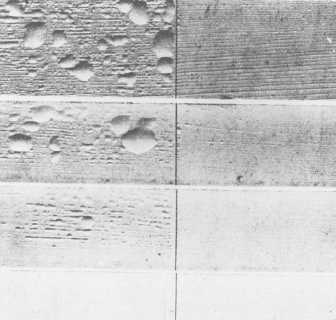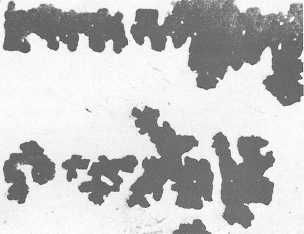in figure 8-5. The root cause of most blistering, other
than that caused by excessive heat, is inadequate
ventilation plus some structural defect allowing
moisture to accumulate under the paint. A prime
source of this problem, therefore, is the use of
essentially porous major construction materials that
allow moisture to pass through. Insufficient drying
time between coats is another prime reason for
blistering. All blisters should be scraped off, the paint
edges feathered with sandpaper, and the bare places
primed before the blistered area is repainted.
Prolonged Tackiness
A coat of paint is dry when it ceases to be
“tacky” to the touch. Prolonged tackiness indicates
excessively slow drying. This may be caused by
insufficient drier in the paint, a low-quality vehicle in
the paint, applying the paint too thickly, painting
over an undercoat that is not thoroughly dry,
painting over a waxy, oily, or greasy surface, or
painting in damp weather.
Inadequate Gloss
Sometimes a glossy paint fails to attain the
normal amount of gloss. This may be caused by
inadequate surface preparation, application over an
undercoat that is not thoroughly dry, or application
in cold or damp weather.
Figure 8-5.—Blistering.
IMPROPER APPLICATION
One particular area you, as a Builder, have
direct control over is application. It takes a lot of
practice, but you should be able to eliminate the two
most common types of application defects: crawling
and wrinkling.
Crawling
Crawling (fig. 8-6) is the failure of a new coat
of paint to wet and form a continuous film over the
preceding coat. This often happens when latex paint
is applied over high-gloss enamel or when paints are
applied on concrete or masonry treated with a
silicone water repellent.
Wrinkling
When coatings are applied too thickly,
especially in cold weather, the surface of the coat
dries to a skin over a layer of undried paint
underneath. This usually causes wrinkling (fig. 8-7).
Wrinkling can be avoided in brush painting or roller
painting by brushing or rolling each coat of paint as
thinly as possible. In spray painting, you can avoid
wrinkling by keeping the gun in constant motion over
the surface whenever the trigger is down.
PAINT DEFECTS
Not all painting defects are caused by the
individual doing the job. It sometimes happens that
the coating itself is at fault. Chalking, checking, and
cracking are the most common types of product
defects you will notice in your work as a Builder.
Figure 8-6.-Crawling.
8-12



